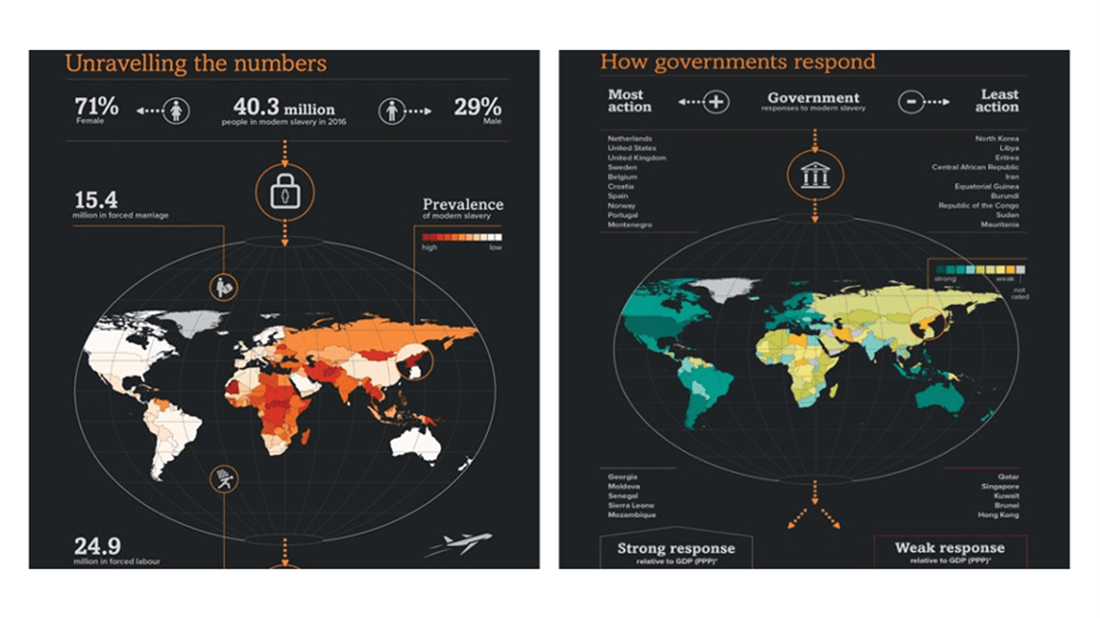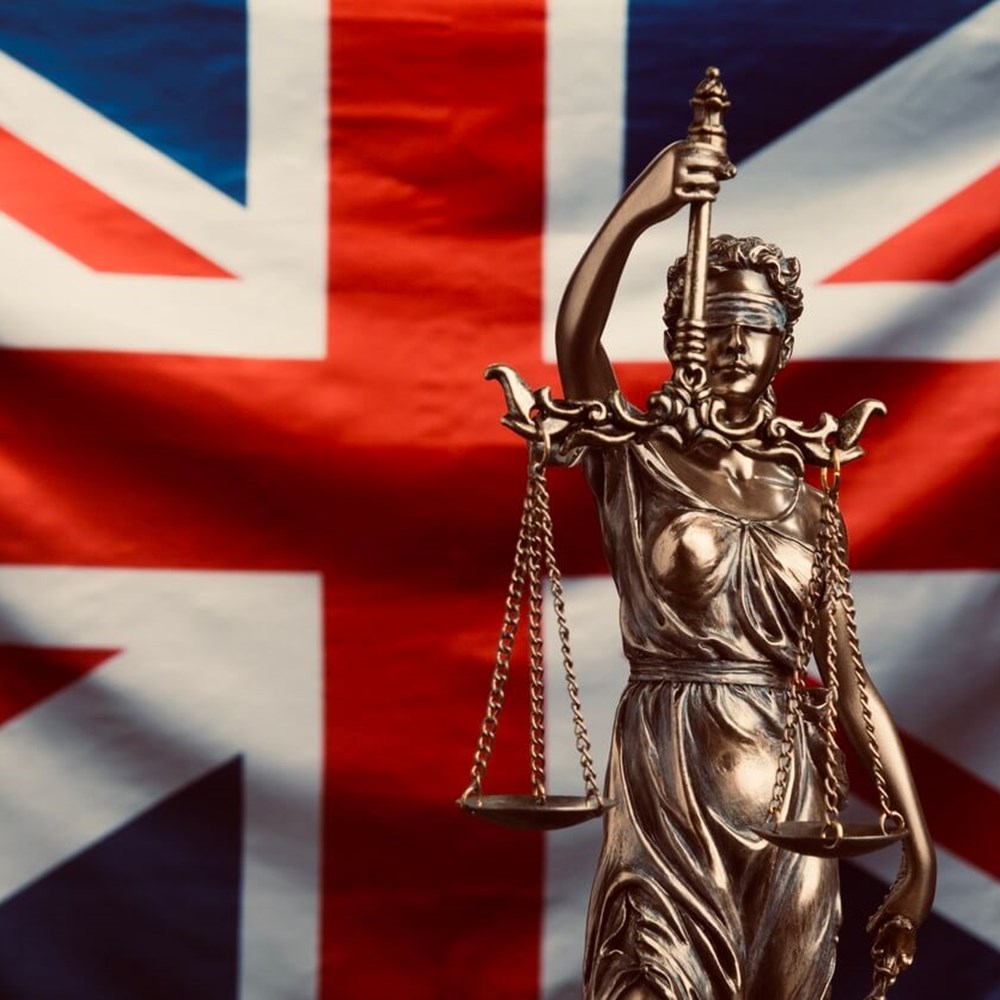The way companies conduct business is changing. Threats from third parties are growing. Geopolitical issues are threatening energy markets. Legislation is tightening regulations all over the world. Legislation has been introduced and updated globally over the past few years that addresses a number of key areas related to procurement and supply chain management. We are going to deeper into the Modern Slavery Act, The Companies Act, EU Accounting Directive, and the Environment Act.
Modern Slavery Act

Image: Walk Free foundation
On 15 June 2021, the Modern Slavery (Amendment) Bill (the ‘Amendment Bill’) was introduced in the House of Lords (the second chamber of the UK Parliament). According to Walk Free, the top 5 categories of spend at risk of modern slavery are the following:
-
Laptops - £151 Bn
-
Garments - £97 Bn
-
Cocoa - £ 10Bn
-
Fish- £ 2.75 Bn
-
Sugarcane - £ 1.6 Bn
The proposal relates to various amendments to the Modern Slavery Act 2015 (the ‘MSA’), the most significant of which are to:
-
Make it a criminal offense to supply a false modern slavery and human trafficking statement
-
Make it a criminal offense for companies to continue to use supply chains which fail to demonstrate minimum standards of transparency
-
Improve standards of transparency in supply chains in relation to modern slavery and human trafficking.
This development is the latest in a series of recent efforts by both the UK Government and members of Parliament to increase the obligations on businesses to prevent modern slavery from occurring in their supply chains and organizations. The Modern Slavery Act (MSA) 2015 which requires commercial businesses (section 54:12) who have an annual turnover of £36m or more and are headquartered in the UK to produce a statement setting out the steps they have taken to ensure there is no modern slavery in their own business and their supply chains. If an organization has taken no steps to do this, their statement should say so. This includes franchises and parent/subsidiary organizations, even those overseas, too. SME’s can voluntarily choose to produce a statement although it is not a legal obligation below the threshold of £36 million.
According to the UK government, the statement should aim to include:
-
The organization’s structure and its supply chains.
-
Policies in relation to slavery and human trafficking.
-
Due diligence processes in relation to slavery and human trafficking in its business and supply chains.
-
Parts of its business and supply chains where there is a risk of slavery and human trafficking and the steps it has taken to assess and manage that risk.
-
Effectiveness in ensuring that slavery and human trafficking is not taking place in its business or supply chains, measured against such performance indicators as it considers appropriate.
-
Training and capacity building about slavery and human trafficking available to its staff.
The statement needs to be approved by an Executive Director and placed on a prominent page on the website. I have provided the definitions of the different forms of slavery from the UK government's website in the appendices for reference.
The Companies Act
The Companies Act 2006 (Strategic Report and Directors’ Report) Regulations 2013 also require UK quoted companies to report within its Strategic Report on human rights issues where necessary for an understanding of the development, performance or position of the company’s business’. This includes any policies a business has in relation to these matters and the effectiveness of those policies. The wording in the Companies Act 2006 does not explicitly mention supply chains or modern slavery. It is left to the individual business to determine what policies are relevant and the level of detail required.
EU Accounting Directive
In October 2014, the European Union adopted a Directive (2014/95/EU) which amended the EU Accounting Directive (2013/34/EU). This amending Directive requires large undertakings that are public interest entities (defined in the Accounting Directive, the definition including credit institutions, insurance undertakings and undertakings whose securities are traded on a regulated market in the EU) with an average number of 500 employees to prepare a ‘non-financial statement’ as part of their management report. The Directive was transposed into UK law on 19th December 2016 and applies to financial years commencing on, or after, 1 January 2017.
The non-financial statement must provide information to the extent necessary for an understanding of the undertaking’s development, performance, position and impact of its activity, relating to, as a minimum, environmental, social and employee matters, respect for human rights, anti-corruption and bribery matters, including:
-
A brief description of the undertaking’s business model
-
A description of the policies pursued by the undertaking in relation to those matters, including due diligence processes implemented
-
The outcome of those policies
-
The principal risks related to those matters linked to the undertaking’s operations including, where relevant and proportionate, its business relationships, products or services which are likely to cause adverse impacts in those areas, and how the undertaking manages those risks
-
Non-financial key performance indicators relevant to the particular business.”
Finally, a company failing to comply with the MSA may then be liable to an unlimited fine if held in contempt of court. However, there is currently no criminal sanction for breaching section 54 of the MSA.
Environment Act
Another key legal instrument that will impact procurement and supply chains is the new Environment Act 2021, enacted on 9th November 2021. In essence it targets and replaces other areas set aside with the advent of Brexit:
-
Creates a new governance framework for the environment
-
Direction for resources and waste management
-
Improving air quality
-
Securing our water services
-
Enhancing our green spaces
-
Updating laws on chemicals (REACH)
The objectives of the new Environment bill are to address:
-
Long-term targets to improve air quality, biodiversity, water, and waste reduction and resource efficiency
-
A target on ambient PM2.5 concentrations, the most harmful pollutant to human health
-
A target to halt the decline of nature by 2030
-
Environmental Improvement Plans, including interim targets
-
A cycle of environmental monitoring and reporting
-
Environmental Principles embedded in domestic policy making
-
Office for Environmental Protection to uphold environmental law
Waste & Recycling
-
Extend producer responsibility to make producers pay for 100% of cost of disposal of products, starting with plastic packaging
-
A deposit Return Scheme for single use drinks containers
-
Charges for single use plastics
-
Greater consistency in recycling collections in England
-
Electronic waste tracking to monitor waste movements and tackle fly-tipping
-
Tackle waste crime
-
Power to introduce new resource efficiency information (labelling on the recyclability and durability of products)
-
Regulate shipment of hazardous waste
-
Ban or restrict export of waste to non-OECD countries
CLEAN AIR
-
Require Local Authorities to tackle air quality
-
Simplify enforcement within smoke control areas
NATURE
-
Strengthened biodiversity duty
-
Biodiversity net gain to ensure developments deliver at least 10% increase in biodiversity
-
Local Nature Recovery Strategies to support a Nature Recovery Network
-
Duty upon Local Authorities to consult on street tree felling
-
Strengthen woodland protection enforcement measures
-
Conservation Covenants
-
Protected Site Strategies and Species Conservation Strategies to support the design and delivery of strategic approaches to deliver better outcomes for nature
-
Prohibit larger UK businesses from using commodities associated with wide-scale deforestation
-
Requires regulated businesses to establish a system of due diligence for each regulated commodity used in their supply chain, requires regulated businesses to report on their due diligence, introduces a due diligence enforcement system
WATER
-
Effective collaboration between water companies through statutory water management plans
-
Drainage and sewerage management planning a statutory duty
-
Minimize damage water abstraction may cause on environment
-
Modernize the process for modifying water and sewerage company license conditions
All of the above measures require each organization to operate differently going forward all of which will impact directly and indirectly the activities in procurement and supply chain management and require the use of data and systems as an absolute imperative given the scale and complexity of most modern supply chains.
Some early commentary has focused on the following:
Digital Waste Tracking
Waste management companies need to be ready to participate in, and eventually be forced into, digital waste tracking schemes. This starts with moving away from paper-based waste management and compliance processes and moving towards open digital systems that help you structure your data and improve your data quality. Crucially, whatever system you use must make your data freely accessible to you, so that you can enjoy the benefits of your own, valuable, clean, structured data, while also being free to easily and quickly change suppliers at no cost if you are not satisfied as to the approach and recognition of the new requirements.
Public Procurement
Both public and private sectors will need to recognize that Environmental Improvement Plans (EIP’s) and other such measures will now filter through into public tenders and will become part of the evaluation criteria along with others that have already explicitly been called out for Social Value (PPN06/20). I have set in the appendices the current 29 laws and regulations governing public procurement as it currently exits for reference ( Legislation.gov.uk). However, in December 2020 a consultation document signaling a change to the diverse and complex set of laws and regulations and stated in the consultation opening document (Transforming Public Procurement (publishing.service.gov.uk):
The procurement procedures for awarding public contracts can be restrictive and create complexity and confusion for buyers and suppliers. This stifles innovation and deters small businesses and start-ups from ever bidding for public contracts. We can get rid of duplication and bureaucracy, making the system more agile and flexible while still upholding fair and open competition. The Government proposes replacing the outdated procurement procedures with a new procedure which will allow for more negotiation and greater engagement with potential suppliers to deliver innovative solutions in partnership with the public sector.
-
We propose slashing the 350+ regulations governing public procurement and integrating the current regulations into a single, uniform framework.
-
We propose overhauling the complex and inflexible procurement procedures and replacing them with three simple, modern procedures:
-
A new flexible procedure that gives buyers freedom to negotiate and innovate to get the best from the private, charity and social enterprise sectors.
-
An open procedure that buyers can use for simpler, ‘off the shelf’ competitions.
-
A limited tendering procedure that buyers can use in certain circumstances, such as in crisis or extreme urgency.
-
We propose removing the Light Touch Regime as a distinct method of awarding contracts and applying the rules applicable to other contracts to services currently subject to this regime.
The consultation period ended on 10th March 2021. On 6th December 2021 the cabinet office finally published a document summarizing the thematic responses to the Green Paper. The consultation exercise stimulated 619 responses, spread roughly equally across public sector buying teams, suppliers into the sector and other interested groups (e.g. trade associations, academics, members of the public and legal advisors).
The response from the cabinet office now sets the scene for the introduction of the Procurement Bill at some stage in 2022 (date still unknown): the expressed intention being to introduce primary legislation with subordinate regulations being brought into force thereafter to put into play specific elements of the new regime.
While the cabinet office do not feel sufficiently confident to pin their colors to a fixed timetable for implementation, at least there is an acknowledgement that the reforms are significant and will require the sector to have a period of time to familiarize themselves with the new regime. The new timetable is intended to include a 6 month notice of ‘go-live’ come what may; the cabinet office have also promised to provide a series of training sessions and materials to assist with this process. In principle, ‘the new regime is unlikely to come into force until 2023 at the earliest.’
As I write this briefing note the commons committee notes from 22nd March have been posted (https://committees.parliament.uk/oralevidence/9967/html/ ) evidencing the development of a common procurement framework (HC-1138). However, no specific details or timeframes were available from those meeting notes. The reality is that the laws and regulations will also be a dynamic space, but it is clear that without effective governance, systems, processes and structured data organizations will either struggle or get left behind.
Additional Read: Insights on the German Supply Chain Due Diligence Act
References:
OECD guidelines on Responsible Business Conduct: Guidelines - Organisation for Economic Co-operation and Development (oecd.org)
Walk Free business guides and toolkits: Business & Investor Toolkit | Walk Free
[probably the most comprehensive e and practical list of guides, videos and case studies you will ever need in this area]
United Nations: GuidingPrinciplesBusinessHR_EN.pdf (ohchr.org)
Guidance and workshops: Stronger Together, tackling modern slavery in supply chains : Stronger Together (stronger2gether.org)
The Modern Slavery Act 2015 (Transparency in Supply Chains) Regulations 2015 (legislation.gov.uk)
UN Guiding Principles on Business and Human Rights (UNGPs)
UN Guiding Principles Reporting Framework
OECD, Guidelines for Multinational Enterprises
ILO Resources on Forced Labour, Human Trafficking and Slavery
The United Nations Convention on the Rights of the Child (UNCRC)
UNICEF, The UN Global Compact and Save the Children, Children’s Rights and Business Principles
Modern slavery statement registry
Walk Free Global Slavery Index
CORE Coalition, Practical Guides
ETI Base Code Guidance: Modern Slavery
ETI Base Code Guidance: Child Labour
ETI Human Rights Due Diligence Framework
ETI and Hult International Business School, Corporate Leadership on Modern Slavery
Environment Act 2021 (legislation.gov.uk)
Appendices:
Definitions of Slavery from UK Government website:
Annex A - modern slavery definition
Modern Slavery is a term used to encapsulate both offences in the Modern Slavery Act: slavery, servitude and forced or compulsory labour; and human trafficking. The offences are set out in section 1 and section 2 of the Act.
Definition of Slavery and Servitude
Slavery, in accordance with the 1926 Slavery Convention, is the status or condition of a person over whom all or any of the powers attaching to the right of ownership are exercised. Since legal ‘ownership’ of a person is not possible, the key element of slavery is the behaviour on the part of the offender as if he/ she did own the person, which deprives the victim of their freedom. Servitude is the obligation to provide services that is imposed by the use of coercion and includes the obligation for a ‘serf’ to live on another person’s property and the impossibility of changing his or her condition.
Definition of Forced or Compulsory Labour
Forced or compulsory labour is defined in international law by the ILO’s Forced Labour Convention 29 and Protocol. It involves coercion, either direct threats of violence or more subtle forms of compulsion. The key elements are that work or service is exacted from any person under the menace of any penalty and for which the person has not offered him/her self voluntarily.
Definition of Human Trafficking
An offenSe of human trafficking requires that a person arranges or facilitates the travel of another person with a view to that person being exploited. The offence can be committed even where the victim consents to the travel. This reflects the fact that a victim may be deceived by the promise of a better life or job or may be a child who is influenced to travel by an adult. In addition, the exploitation of the potential victim does not need to have taken place for the offence to be committed. It means that the arranging or facilitating of the movement of the individual was with a view to exploiting them for sexual exploitation or non-sexual exploitation. The meaning of exploitation is set out on legislation.gov.uk.
Definition of Child Labour
Child labour is defined by international standards as children below 12 years working in any economic activities, those aged 12-14 engaged in more than light work, and all children engaged in the worst forms of child labour (ILO).
The term “child labour” is often defined as work that deprives children of their childhood, their potential and their dignity, and that is harmful to physical and mental development. Whether or not particular forms of “work” can be called “child labour” depends on the child’s age, the type and hours of work performed, the conditions under which it is performed and the objectives pursued by individual countries.
Children can be particularly vulnerable to exploitation, but child labour will not always constitute modern slavery. It will still be necessary to determine whether, based on the facts of the case, the children in question are being exploited in such a way as to constitute slavery, servitude and forced or compulsory labour or human trafficking. For example, it is possible for children to undertake some ‘light work’ which would not necessarily constitute modern slavery. ‘Light work’ is defined by article 7 of ILO Convention No. 138.
Children do have particular vulnerabilities which should be considered when determining whether modern slavery is taking place. The Modern Slavery Act 2015 specifically recognizes that it is not necessary for a child to have been forced, threatened or deceived into their situation for it to be defined as exploitation.
List of all current 29 laws and regulations:













